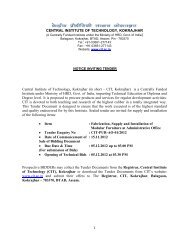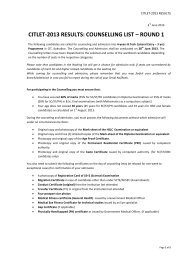1st YEAR: 1st SEMESTER (JULY-DEC) - CIT, Kokrajhar...
1st YEAR: 1st SEMESTER (JULY-DEC) - CIT, Kokrajhar...
1st YEAR: 1st SEMESTER (JULY-DEC) - CIT, Kokrajhar...
- No tags were found...
Create successful ePaper yourself
Turn your PDF publications into a flip-book with our unique Google optimized e-Paper software.
CENTRAL INSTITUTE OF TECHNOLOGY(Centrally Funded Institute Under the Ministry of HRD, Govt. of India)Bodoland Territorial Council, <strong>Kokrajhar</strong>, Assam-783370(B.Tech Syllabus in Instrumentation Engineering)IE301: NETWORK THEORYCode: IE301Credit: 04L-T-P: 3-1-0Basic Circuit ConceptsLumped circuits – circuit elements, ideal sources (independent and dependent), linear passiveparameters R, L and C, V-I relationship of circuit elements – Sinusoidal voltage and current:RMS value, form factor – Kirchoff’s Laws – analysis of series and parallel circuits – networkreduction: voltage and current division, source transformation, star/delta transformationTransient Analysis of First & Second Order CircuitsSource free response of RL and RC circuits – forced (step) response of RL and RC circuits –source free response of RLC series circuit – forced (step) response of RLC series circuit – forcedresponse of RL, RC and RLC series circuit to sinusoidal excitation – Time constant and naturalfrequency of oscillation of circuits – Laplace Transform application to the solution of RL, RC &RLC circuits – Initial and final value theorems and applications – concept of complex frequency– driving point and transfer impedance – poles and zeros of network function.Sinusoidal Steady State AnalysisConcept of phasor and complex Impedance / Admittance – Analysis of simple series and parallelcircuits – active power, reactive power, apparent power (voltampere), power factor and energyassociated with these circuits – concept of complex power – phasor diagram, impedance triangleand power triangle associated with these circuits – resonance in series and parallel circuits – Qfactor, half-power frequencies and bandwidth of resonant circuits.Multi Dimensional Circuit Analysis & Network TheoremsNode–voltage analysis of multi node circuit with current sources – rules for constructing nodaladmittance matrix [Y] for solving matrix equation [Y]V=I - Mesh-current analysis of multi nodecircuits with voltage sources – rules for constructing mesh impedance matrix[Z] for solvingmatrix equation [Z]I=V – Super position theorem – Thevenin’s theorem – Norton’s theorem –Reciprocity theorem – Compensation theorem – Tellegen’s theorem – Millman’s theorem –maximum power transfer theorem for variable resistance load, variable impedance load andvariable resistance and fixed reactance load.Coupled Circuits and Three Phase CircuitsCoupled circuits: mutual inductance – coefficient of coupling – dot convention – analysis ofsimple coupled circuits – Three phase circuits: three phase balanced/ unbalanced voltage sources– analysis of three phase 3-wire and 4-wire circuits with star and delta connected loads, balanced& unbalanced – phasor diagram of voltages & currents – power and power factor measurementsin three phase circuits.Page 42 of 75
















